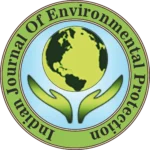IJEP 44(9): 841-850 : Vol. 44 Issue. 9 (September 2024)
Kanni Raj Arumugam Pillai* and Yara EzAl Deen Sultan
Vel Tech Rangarajan Dr. Sagunthala R and D Institute of Science and Technology, Department of Chemistry, School of Sciences and Humanities, Chennai – 600 062, Tamil Nadu, India
Abstract
This modelling work aims to understand climate change and calculate atmospheric carbon dioxide content from it. Because the work relies mainly on secondary data, the information was gathered through journal articles. Data for climate models, artificial intelligence fire models and landscape succession models were analyzed to correlate climate change and forest fires. Climate changes are assessed simply from the level of greenhouse gas emissions. Meanwhile, forest fire risk, frequency and intensity were derived from climatic data. Statistical fire models derived from previous fire data provide a reasonably good fire risk estimate. These models nowadays work on satellite imagery of both green cover and forest fire using deep learning method to predict all forest fire variables. Deep learning updates forest green cover data and forest fire data from daily satellite imaging. This updating method provides best input for the model and in turn, helps in better prediction. In real-time forestry, this model acts as a fire ready formula for firefighters. This model application is compulsory for futuristic forestry in ever increasing hotter climates.
Keywords
Climate change, Forest fire, Artificial intelligence, Landscape succession, Model
References
- Sultan, Y.E.D. and K.R.A. Pillai. 2023. Wild fires and climate change: Health, air quality, wild fires and causes in India. Indonesian J. Social Env., 4(1): 72-80.
- Pillai, K.R.A. and Y.E.D. Sultan. 2023. Wildfire models- Concise review. Int. J. Innovative Res. Tech., 10(3): 161-166.
- Dupuy, J.L., et al. 2020. Climate change impact on future wildfire danger and activity in southern Europe: A review. Annals Forest Sci., 77: 35.
- Abatzoglou, J.T. and A.P. Williams. 2016. Impact of anthropogenic climate change on wildfire across western US forests. Earth Atmos. Planetary Sci., 113(42): 11770-11775.
- Rossiello, M.R. and A. Szema. 2019. Health effects of climate change-induced wildfires and heatwaves. Cureus. 11(5): e4771.
- Cosimo, M., et al. 2021. Heterogeneous effects of temperature and emissions on economic productivity across climate regimes. Sci. Total Env., 775: 145893.
- Lineman, M., et al. 2015. Talking about climate change and global warming. Plos One. 10(9): e0138996. DOI: 10.1371/journal.pone.0138996.
- Mina, U., A.P. Dimri and S. Farswan. 2023. Forest fires and climate attributes interact in central Himalayas: An overview and assessment. Fire Ecol., 19: 14. DOI: 10.1186/s42408-023-00177-4.
- Hamermesh, N. 2010. Mathematical modelling of climate change: Examining the diurnal temperature range. Bryn Mawr College, Pensyllvania, USA.
- Goosse, H., et al. 2009. Introduction to climate dynamics and climate modelling. Universite Catholique de Louvain, Louvain-la-Neuve, Belgium.
- Postma, J.E. 2012. A discussion on the absence of a measurable greenhouse effect. Principia Scientific International, London, UK.
- Singh, S. 2022. Forest fire emissions: A contribution to global climate change. Frontiers Forests Global Change. (5): 925480.
- Wu, Z., et al. 2022. Simulation of forest fire spread based on artificial intelligence. Ecol. Indicators. 136: 108653.
- Mishra, B., et al. 2023. Forest fire pattern and vulnerability mapping using deep learning in Nepal. Fire Ecol., 19: 3.
- Xu, Y., et al. 2022. Modelling forest fire spread using machine learning-based cellular automata in a GIS environment. MDPI J. Forests. 13: 1974.
- Heidari, H., M. Arabi and T. Warziniack. 2021. Effects of climate change on natural-caused fire activity in western U.S. national forests. MDPI J. Atmos., 12(8): 981.
- DeCastro, A.L., et al. 2022. A computationally efficient method for updating fuel inputs for wildfire behaviour models using sentinel imagery and random forest classification. MDPI J. Remote Sensing. 14(6): 1447.
- Roy, D.P. and S.S. Kumar. 2017. Multi-year MODIS active fire type classification over the Brazilian tropical moist forest biome. Int. J. Digital Earth. 10(1): 54-84.
- Bisquert, M., et al. 2012. Application of artificial neural networks and logistic regression to the prediction of forest fire danger in Galicia using MODIS data. Int. J. Wildland Fire. 21(8): 1025-1029.
- Varanasi, L.V.S., et al. 2022. Early detection of forest fire using mixed learning techniques and UAV. Hindawi J. Computational Intelligence Neuro-sci., 3170244.
- Keane, R.E., et al. 2022. Modeled interactions of mountain pine beetle and wildland fire under future climate and management scenarios for three western US landscapes. Fire Ecol., 18(1): 12.
- Loehman, R.A., R.E. Keane and L.M. Holsinger. 2020. Simulation modelling of complex climate, wildfire and vegetation dynamics to address wicked problems in land management. Frontiers Forests Global Change. 3: 3.
- Keane, R.E., et al. 2016. Evaluating future success of whitebark pine ecosystem restoration under climate change using simulation modelling: Simulating climate impacts on restoration treatments. Restoration Ecol., 25(2): 220-233.
- Yospin, G.I., et al. 2015. Modelling vegetation mosaics in sub-alpine Tasmania under various fire regimes. Modelling Earth Systems Env., 1(3): 16.
- Hanan, E.J., et al. 2022. Missing climate feedbacks in fire models: Limitations and uncertainties in fuel loadings and the role of decomposition in fine fuel accumulation. J. Adv. Modelling Earth Systems. 14(3): e2021MS002818.
- Syphard, A.D., et al. 2018. Mapping future fire probability under climate change: Does vegetation matter? Plos One. 13(8): e0201680.
- Halofsky, J.E., D.L. Peterson and B.J. Harvey. 2020. Changing wildfire, changing forests: The effects of climate change on fire regimes and vegetation in the Pacific Northwest, USA. Fire Ecol., 16: 4.
